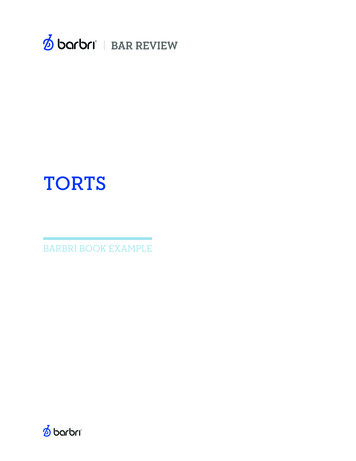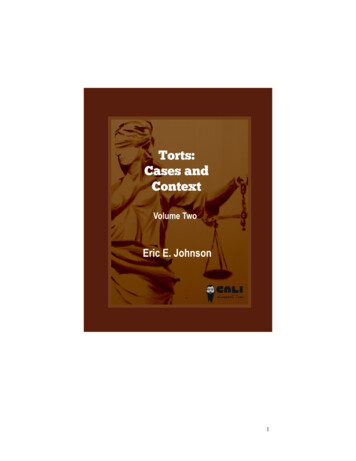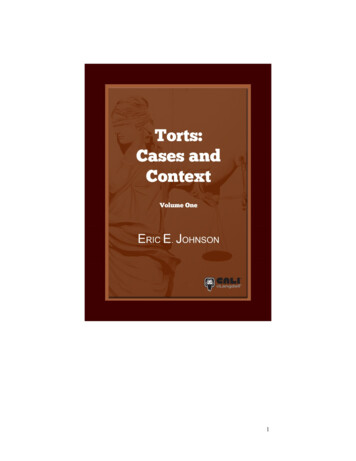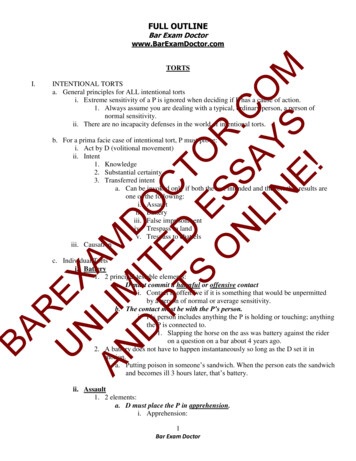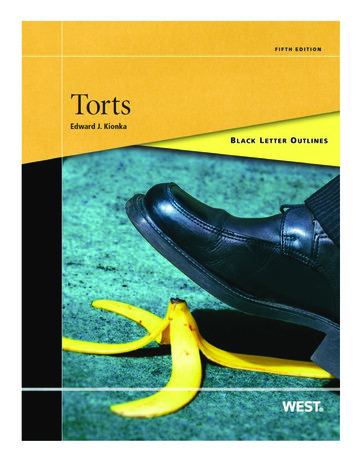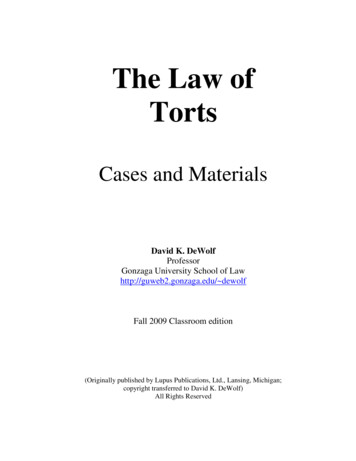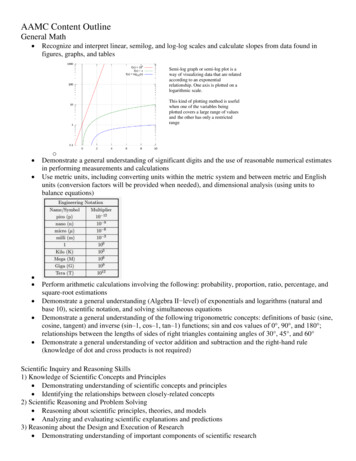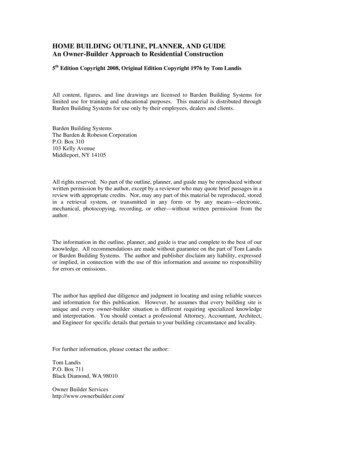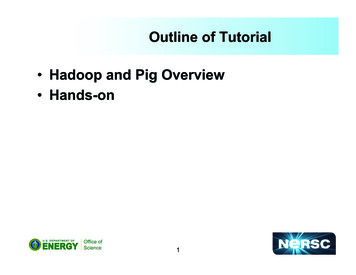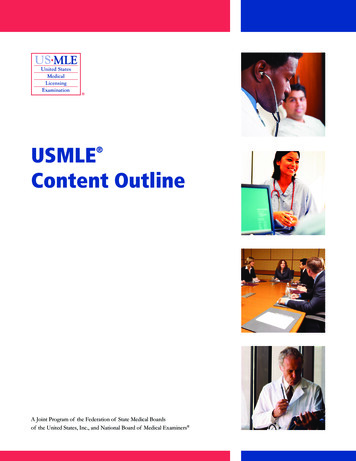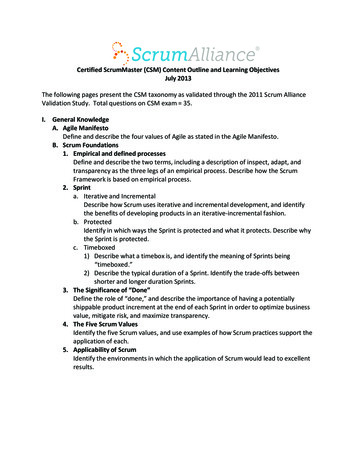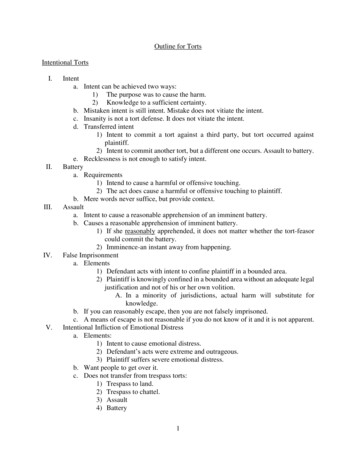
Transcription
Outline for TortsIntentional TortsI.II.III.IV.V.Intenta. Intent can be achieved two ways:1) The purpose was to cause the harm.2) Knowledge to a sufficient certainty.b. Mistaken intent is still intent. Mistake does not vitiate the intent.c. Insanity is not a tort defense. It does not vitiate the intent.d. Transferred intent1) Intent to commit a tort against a third party, but tort occurred againstplaintiff.2) Intent to commit another tort, but a different one occurs. Assault to battery.e. Recklessness is not enough to satisfy intent.Batterya. Requirements1) Intend to cause a harmful or offensive touching.2) The act does cause a harmful or offensive touching to plaintiff.b. Mere words never suffice, but provide context.Assaulta. Intent to cause a reasonable apprehension of an imminent battery.b. Causes a reasonable apprehension of imminent battery.1) If she reasonably apprehended, it does not matter whether the tort-feasorcould commit the battery.2) Imminence-an instant away from happening.False Imprisonmenta. Elements1) Defendant acts with intent to confine plaintiff in a bounded area.2) Plaintiff is knowingly confined in a bounded area without an adequate legaljustification and not of his or her own volition.A. In a minority of jurisdictions, actual harm will substitute forknowledge.b. If you can reasonably escape, then you are not falsely imprisoned.c. A means of escape is not reasonable if you do not know of it and it is not apparent.Intentional Infliction of Emotional Distressa. Elements:1) Intent to cause emotional distress.2) Defendant’s acts were extreme and outrageous.3) Plaintiff suffers severe emotional distress.b. Want people to get over it.c. Does not transfer from trespass torts:1) Trespass to land.2) Trespass to chattel.3) Assault4) Battery1
VI.VII.VIII.5) False ImprisonmentTrespass to landa. Elements1) Intent to go on to the land of another.2) Unauthorized entry.3) Entered land of anotherb. Prior rule: property up to heaven and down to the center of the earth.1) New rule: whether it is close enough and affects the enjoyment of the use.Trespass to chattela. Element:1) Intent to intermeddle with or use the chattel (property) of another.2) Chattel is the plaintiff’s to have.3) Causes:A. An impairment in condition, quality, or value.B. Possessor is deprived of use for substantial time.C. Harm is caused to the possession or other legally protected interest.Conversiona. Elements1) Intent to exercise dominion over chattel.2) So seriously interferes with plaintiff’s right of control that the remedy isjustified.b. Remedy is a forced sale-has to pay full value of chattel but defendant keeps chattel.c. Good Faith Purchaser-Can use this as a defense unless chattel was stolen. Plaintiffcan only win if third party stole it, unless the defendant bought it from business inthe business of selling that item.Privileges (defenses to intentional torts)I.II.III.Consenta. Silence does not mean consent. Fact specific.b. The issue is not whether there was actual consent, but whether a reasonable personwould have reasonably consented.c. Consent given by a mistake is still valid, unless defendant induced the mistake(misrepresentation, fraud, or duress) or should have known the plaintiff’s consentwas based on a false pretense.d. In most states, consent to a criminal act is not valid.Self-defense:a. defendant (who has the burden of proof) is not liable for tort if:1) It was performed under a reasonable belief by the defendant that he is orwas about to be attacked; and,2) Constituted reasonable force. Meaning:A. That it was reasonable to use force.B. Amount of force used was reasonable.b. Some states require a retreat when it is reasonably safe to do so (except in thehome).Defense of others.2
IV.V.VI.VII.a. If a third party would have been privileged to use self-defense, defendant isprivileged to use reasonable force on the third party’s behalf.Defense of Propertya. Defendant is privileged to use a reasonable amount of force to prevent a tort againsthis property.b. Less than the amount for self-defense and almost never deadly force.Recovery of propertya. Defendant may be privileged to use reasonable force to recover wrongfullyobtained chattel:1) Defendant must be in uninterrupted fresh pursuit.2) A mistake vitiates the privilege.A. Except for shopkeepers who reasonably suspect a person ofshoplifting.Necessitya. A defendant may commit an intentional tort if it is reasonably necessary to preventa further injury.b. The threat must be:1) Natural/external2) Substantially more serious than the interference.3) Sudden, unexpected, and temporary.c. If acting to protect the public at large, the privilege is an absolute one and defendantneed not pay for damages. If the act is to protect a private interest, he mustcompensate the plaintiff for damage, but is allowed to act.Common law certain people, i.e. parents, teachers, and wardens are allowed to usereasonable force to maintain discipline.NegligenceI.II.III.IV.Elementsa. Defendant had a duty to plaintiffb. That duty was breachedc. That breach caused1) Causation in fact.2) Proximate cause.d. DamagesThe Learned Hand Testa. B PL1) Burden of taking steps to avoid harm.2) Magnitude if harm occurs (L).3) Probability of it occurring (P).A. Actual quantities not needed.Customary practices can be used as evidence that a standard of care was breached, but it isnot the standard itself.Standards of care:a. The reasonable prudent person, an objective standard.3
V.1) Ordinary intelligence, perception, and memory with the physicalcharacteristics of the defendant.2) In general, a defendant’s general mental characteristics or deficiencies arenot taken into account.3) The context must be considered as well.4) Special knowledge raises the standard.b. Children are held to a subjective standard, and children under a certain age cannotbe held negligent at all. Age, maturity, intelligence, training, and experience.1) Children engaged in adult activities (driving or snowmobiling) are held tothe adult standard.c. Insanity is not a defense.d. Professionals are held to an objective standard of an ordinary member of theprofession.1) If there is a specialty, they are raised to that standard.2) Custom of profession/specialty is the standard generally.3) Liability cannot be based on a disagreement or failure of tactics.e. Medical Malpractice allows, sometimes, for the standard to be set locally (minorityrule) or by similar areas (majority rule). Other use a national standard (minorityrule).f. Informed Consent1) Baseline RuleA. Custom is that doctor has to disclose X (Duty)B. Doctor did not disclose X (breach).C. With that knowledge the plaintiff would not have had the surgery.D. Damages were caused.2) Canterbury Rule:A. A doctor must disclose what a reasonable person would want toknow. (Material Risks). (Minority Rule)B. Doctor did not discloseC. Patient needs to show (Majority Rule)1. That a reasonable patient, upon learning of the risk, wouldnot have consented; and,2. That the patient would not have consent.g. Doctors have a duty to disclose any profit or research interests of the treatment.Negligence Per se.a. Duty and breach are set by a statute or administrative regulation.1) An alternative method of establishing negligence, not an exclusive one.b. The statute is designed to prevent this sort of injury from this sort of victim-zoneof protection.c. The court must also decide if the statute is appropriate to be a civil duty byconsidering:1) Difficulty in proving causation2) Creates a new civil duty.3) Is the liability too strict (too detached from defendant’s level of care)?4) Disproportionate liability compared to criminal law.5) Too vague of a duty.4
VI.d. Majority rule for excuses, which the defendant has the duty to prove:1) Incapacity or reasonable inability to comply.2) No knowledge of violation (ignorance of facts, not law).3) Unable after reasonable diligence to comply.4) Emergency not of the defendants making.5) Greater risk of harm to comply.e. Minority rule is that NPS is only evidence of unreasonableness which the defendantmust rebut by an excuse.Proof of Negligencea. Circumstantial evidence, which allows a fact finder to draw inferences, is okay.b. Res ipsa loquitur-when a plaintiff cannot show exactly what was done, it maysuffice to show that defendant was negligent through inference.1) The accident was not the type which would have occurred unless someonewas negligent. And,2) Defendant exercised substantial control over the injury causing instrument.Therefore,3) The accident was caused by defendant’s negligence.A. Used to help survive a pre-trial motion with little evidence.CausationI.II.Causation-in-facta. 2 separate elements which must be met1) Causation-in-fact (but for)2) Proximate cause (legal cause)b. Causation in fact: but for defendant’s negligence the injury and damages would nothave occurred.1) Can be more than one.2) There must be a causal link, in that the negligence must be something thatmakes the result more likely.c. Plaintiff must produce evidence that defendant more than likely caused the injury.1) Must show that the harm was more than twice as likely with the defendant’snegligence then without it. Otherwise, the evidence suggests the injurywould have occurred anyway.d. If there are two causes, both of which are sufficient to have caused the injury, theycancel each other out as “but for” causes. In these cases, causation can bedetermined based on whether the negligence was a “substantial factor” in causingharm and allows a defendant to be held liable, who otherwise would not be liablefor his negligence.e. If there are multiple possible negligent causes and the plaintiff cannot know whichwas the cause, the court will shift the burden to the defendants to prove who caused.f. Sindell uses a market share to apportion liability. Uncommon.Proximate cause is less a matter of fact and logic, but how broadly the courts wish to allowa defendant to be held liable for the damages he causes-in-fact.a. Was the injury within the scope of risk that the defendant created with by thedefendant’s negligence? (Foreseeability)5
III.IV.V.A. The type of accident is what needs to be foreseeable, not the exactsequence of events.b. Intervening causes-Causes-in-fact of an injury that arises subsequent in time todefendant’s negligence.1) Foreseeable-is the intervening cause in scope of the risk. More foreseeable,less superseding.2) Independent-More independent, more superseding. An Act of God typething, which would have occurred without defendant’s negligence.A. Superseding cause is an intervening cause that is so powerful thatdefendant is not a proximate cause.B. Intentional torts are very likely to be a superseding cause, thoughnot necessarily.C. Subsequent injury or malpractice is not a superseding cause.c. Rescue doctrine-Precludes a case from getting dismissed for lack of foreseeability.Plaintiff must still establish other elements.1) If attempt to rescue is foolish, might be superseding.2) Firefighter’s rule-precluded from claim if the injury was within the scopeof the job.Public Policya. Social hosts cannot be liable for their drunk driving guest, unless the guest is aminor.b. Plaintiffs not conceived or exposed at the time the injury was inflicted.Comparative Negligence.a. Contributory negligence-the minority rule which states that is plaintiff is negligentat all there can be no recovery.1) Exceptions:A. When defendant had the last clear chance to prevent the injury.B. Treating plaintiff more forgivingly when defendant was proximatecause.b. Comparative Negligence-The majority rule where plaintiff can recover if negligent,but the award will be reduced by percentage of plaintiff’s fault.1) Pure-minority rule where plaintiff can recover no matter who much wasthere fault.2) Modified-majority rule, where plaintiff has to be less than 50% (49% insome states) to recover.Assumption of Riska. Express assumption of the risk (all states still do this).1) Conflict between tort common law and contracts, contracts win.2) Enforced unless:A. It contravenes public policy (such as for essential services where theplaintiff had no choice).B. Defendants tort was intentional or wanton-and-willful;C. The injury was medical malpractice.D. Contract waived application of a safety statute.b. Implied assumption of the risk (most states do not use).1) Actual knowledge of the risk.6
VI.VII.2) Actual knowledge of the risks magnitude.3) Plaintiff voluntarily encounters risk.A. All risks, not just unreasonable risks.B. Does not apply when there is no other alternative.C. Constructive knowledge not good enough.c. Implied assumption of risk is replaced with comparative negligence.Statute of Limitationa. Certain amount of time to file a lawsuit.b. Discovery rule-time begins when plaintiff knows or should have known of theinjury.c. Cannot wait until the injury gets worse.d. Procedural defense which the defendant must make it within a reasonable time.e. Tolling1) Minor does not start until she is 18.2) Fraudulent concealment.Statute of Reposea. Substantive.b. Begins at the time of injury and runs for the time set by statute. Afterwards, it cannotbe brought.1) Not subject to tolling.2) Usually long, 10-20 years, and for things like buildings.ImmunityI.II.III.Spousal immunitya. Most states have gotten rid of it mostlyb. It was based on:1) Unity of husband and wife as 1 person.2) Ruins peace and tranquility of marriage union.3) Other ways, i.e., criminal laws and divorce4) Do not want these kinds of lawsuits.A. Marriage ended in the meantime.B. Tort occurred before marriage.C. Intentional torts.D. Car insurance.5) Fraud or collusion.Parent-childa. Most states have gotten rid of it mostly.b. Majority rule was to keep part of it when it is within the parental capacity.c. Not allowed for:1) Relation was only incidental to the case.2) Willful and wanton3) Intentional tortsState and Local Government Immunitya. Every state has different l
Outline for Torts Intentional Torts I. Intent a. Intent can be achieved two ways: 1) The purpose was to cause the harm. 2) Knowledge to a sufficient certainty. b. Mistaken intent is still intent. Mistake does not vitiate the intent. c. Insanity is not a tort defense. It does not vitiate the intent. d. Transferred intent
